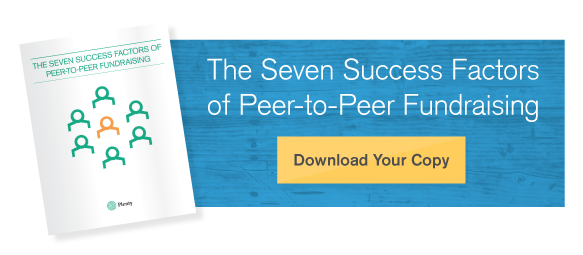Creating Impact With Limited Resources
In the past month, I’ve transitioned from urban planning in the public sector to the peer-to-peer fundraising world at Plenty. Before this shift I worked on countless planning projects that involved the studying of urban vacant lots and the techniques that can be used to stabilize these hazardous parcels through greening and landscaping treatments. And while the connection between vacant lots and nonprofit fundraising may not seem intuitive at first, after reflecting on some of the best practices and lessons learned that came from my work, the parallels between both types of organizations became increasingly obvious.
Vacant lots can pose a variety of challenges to communities ranging from crime in abandoned buildings to the negative impact that continued disinvestment can yield on property values and neighborhood stability. And while a few vacant lots won’t destroy a neighborhood, numerous Rust Belt cities face thousands of vacant lots that wreak havoc on urban systems and the fabric of communities. Therefore, managing a challenge of this magnitude requires the coordination of various stakeholders and the strategic allocation of limited resources — an endeavor that most nonprofits are all too familiar with.
From the comfort of my cubicle, I read the news articles, crunched the numbers, and spoke with outreach coordinators and program managers at local organizations who were dedicating their entire workday — if not more — to fighting an overwhelmingly uphill battle. I was moved by the devotion, resilience, and strategy employed by some of these local leaders as they progressed toward their goal one lot at a time. While more than once there was mention of the challenge of having “limited resources” and moving forward through the “small victories,” I was struck by the staggering impact — despite limited resources — that these small victories actually added up to.
As I began to dig further into the processes that were transforming neighborhoods lot by lot, I came across several key approaches that enabled these organizations to unlock and maximize their resources, including:
- Aligning programs and campaigns with organizational goals.
- Strategically selecting program target areas.
- Coordinating priorities, resources, and timelines.
- Maintaining a fresh outlook and creative approach to addressing challenges.
- Engaging a unique team to mobilize unlikely resources.
Now at Plenty, I realize that these approaches are not just best practices for turning an abandoned lot into a community garden, but rather guidelines for generating impact with limited resources and paths to finding abundance amidst a seemingly scarce landscape. At Plenty, we believe that there is plenty to go around — we just have to find the right way to unlock the abundance. So while your fundraising efforts probably aren’t focused on greening vacant lots, these approaches can help you mobilize and maximize your resources to expand your impact.
Align Your Programs and Campaigns with Your Organizational Goals
Develop your program, project, or campaign so that it specifically fits within the framework and mission of your organization. Support from management, peers, and constituents will come more naturally as everyone moves in the same direction.
Demonstrating how your campaign directly advances movement toward these goals helps keep everyone on the same page and confirms the organizational investment in your campaign. Part of this ties back to knowing who you are as an organization and focusing on programmatic efforts that move you confidently in that direction.
Strategically Select Program Target Areas
It is simply not realistic to “green” 5,000 vacant lots overnight. That being said, there are certain lots that should be addressed first. They are the ones with the highest potential to generate impact. And much like these lots, your program also has some “low-hanging fruit” or quick, intuitive wins that can help build both internal team momentum as well as external support.
Pay attention to when and where your supporters are engaging with you and build off of that already existing momentum. Consider how staff, volunteers, and fundraisers are currently supporting your efforts. What is already performing well? How can you expand on that success? Use these answers to guide your efforts.
You don’t have to take everything on at once, just find the activities that will pack the most punch and allow you to advance toward your goal while conserving resources for more challenging projects. Don’t forget the power of progress. Sometimes adding that one win to the scoreboard can result in a significant boost in your team’s morale.
Coordinate Priorities, Resources, and Timelines
Before fully diving into a new program or campaign, take some time to consider how both the low-hanging fruit as well as the more challenging projects fit within other organizational priorities and obligations. Identifying how different types of projects fit within your organization’s timeline and what resources they require will allow you to systematically address key projects while staying within budget. Thinking about this before you start a project, as opposed to halfway through will save you time and frustration. Sometimes even the easy wins cannot be taken on right away due to timing and budget constraints so consider the implications of starting a project before you begin.
Maintain a Fresh Perspective
While it is easy to slip into a “this is how we do things” mindset after implementing a strategy with a set approach over and over again, it is helpful to take a fresh, critical, and even creative look at your current methods of operation to evaluate if they truly are the most effective way to address the problem at hand.
What do you do when you don’t have the organizational capacity to mow 4,000 vacant lots? Grab a shovel and test out a new ground cover mix that requires less mowing. Pilot projects serve as a great mechanism to experiment with new approaches with minimal risk to current operating procedures. Once these creative approaches have been tested and refined, scale up!
Foster Unique and Engaged TeamsIt can be difficult to generate a fresh perspective when you’re buried in the details of your program everyday, which makes an outside perspective truly invaluable to the success of your organization. It is crucial to collaborate with individuals that bring a new, and perhaps even unconventional, perspective to the table. External feedback and insight will allow you to easily surface areas in need of improvement and potential opportunities you may be overlooking. A team with diverse experiences and interests can also expand your nonprofit’s network and reach, and oftentimes dig up additional resources and avenues to success in the process.
It’s easy to be overcome by the feeling that there is so much work to be done and never enough time, funding, or other resources to make those goals a reality. When your organization is looking to change your community, industry, or world for the better, you’re going to face real challenges and unexpected issues that require tackling. At the same time, you’re the innovator, the problem-solver, and the strategist that bridges the canyon between problem and solution.
It’s rarely an easy task to find the shovels, seed, and manpower required to shift thousands of lots from vacant to vibrant, or the funding, staff, and time to fulfill your mission overnight, but the resources you need do exist. Sometimes a new perspective is necessary to uncover the hidden opportunities. Sometimes a new strategy is needed to get more mileage out of the resources you’ve already tapped into. In either case you have the power to take the tools and team you have and make real impact.
Leveraging the areas of your program that have the highest potential to create impact becomes increasingly important when you have limited resources at your disposal. Download our free e-book "The Seven Success Factors of Peer-to-Peer Fundraising" today to learn more about how you can improve and leverage the seven most critical areas of your fundraising program to achieve success.
Share this
You May Also Like
These Related Stories




No Comments Yet
Let us know what you think